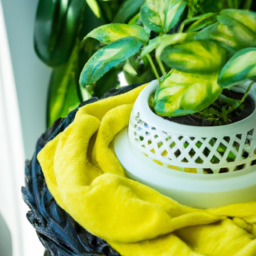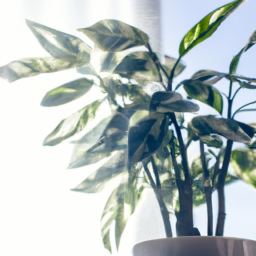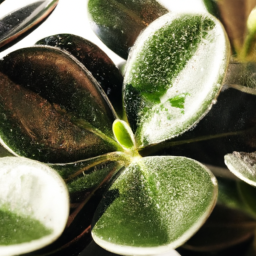
Did you know that plants can play a crucial role in improving the air quality of your home? It’s true! Plants and air quality are closely connected, with certain types of plants acting as natural purifiers that can help create a healthier living environment for you and your family. In this blog post, we’ll explore the fascinating relationship between plants and air quality, and discover how incorporating a few green friends into your living space can have a positive impact on your overall well-being. So, let’s dive in and learn more about how plants can be natural purifiers for healthier living.
The Role of Plants in Improving Indoor Air Quality
When it comes to creating a healthier living environment, plants play a crucial role in improving indoor air quality. Not only do they add beauty and a sense of tranquility to our homes and offices, but they also act as natural purifiers, effectively removing harmful toxins from the air we breathe. In this article, we will explore the various ways in which plants contribute to cleaner and fresher indoor air, and provide you with a step-by-step guide on how to incorporate plants into your living spaces for maximum benefits.
Understanding the Benefits of Plants for Indoor Air Quality
Plants have the incredible ability to absorb and filter harmful pollutants from the air through a process called phytoremediation. They do this by taking in carbon dioxide and releasing oxygen, while also absorbing volatile organic compounds (VOCs) such as formaldehyde, benzene, and trichloroethylene. These VOCs are commonly found in household products, furniture, and building materials, and can have detrimental effects on our health if not properly addressed.
Furthermore, plants also increase humidity levels in indoor spaces, which can help alleviate respiratory problems and reduce the risk of dry skin and allergies. They act as natural humidifiers, releasing moisture through a process called transpiration. This is especially beneficial during the winter months when heating systems tend to dry out the air, leading to discomfort and potential health issues.
Research has shown that incorporating plants into indoor spaces can lead to a significant reduction in air pollutants, resulting in improved cognitive function, increased productivity, and a general sense of well-being. Now that we understand the benefits, let’s dive into the step-by-step guide on how to choose and care for indoor plants to enhance air quality.
Step 1: Assess Your Indoor Environment
The first step in improving indoor air quality with plants is to assess your indoor environment. Consider factors such as lighting conditions, temperature, and available space. Different plants have varying requirements, so it’s important to choose ones that will thrive in your specific setting. Take note of any potential sources of air pollution, such as smoking areas or chemical cleaning products, as this will help you determine the number and types of plants needed to effectively purify the air.
Additionally, consider the size of the room and the amount of natural light it receives. Some plants require direct sunlight, while others can thrive in low-light conditions. Understanding these factors will guide you in selecting the right plants for your space.
Step 2: Choose the Right Plants
Once you have assessed your indoor environment, it’s time to choose the right plants for air purification. Some of the most effective air-purifying plants include the snake plant, spider plant, peace lily, and aloe vera. These plants have been proven to remove a wide range of toxins from the air and are relatively easy to care for.
Consider the size and growth habit of the plants to ensure they fit well in your space. If you have limited space, opt for smaller plants that can be placed on shelves or countertops. If you have larger areas to fill, consider plants with trailing vines or tall, bushy foliage to create a lush and inviting atmosphere.
Step 3: Provide Proper Care and Maintenance
Once you have chosen your plants, it’s essential to provide them with the proper care and maintenance they need to thrive and effectively purify the air. This includes watering them regularly, providing adequate light, and ensuring proper drainage to prevent root rot. Different plants have different care requirements, so it’s important to research and understand the specific needs of each plant you choose.
In addition to regular watering and light exposure, it’s also beneficial to periodically clean the leaves of your plants to remove dust and debris. This will ensure that the plants can effectively perform their air-purifying functions. Simply wipe the leaves gently with a damp cloth or give them a gentle shower to keep them clean and healthy.
In conclusion, plants are not only aesthetically pleasing but also serve as natural purifiers for healthier living. By incorporating plants into your indoor spaces, you can significantly improve air quality, reduce the presence of harmful toxins, and create a more pleasant and inviting environment. Remember to assess your indoor environment, choose the right plants, and provide proper care and maintenance for optimal results. So go ahead, bring nature indoors, and breathe in the benefits!

Plants and Air Quality: Natural Purifiers for Healthier Living
2. Common Houseplants That Act as Natural Air Purifiers
When it comes to improving indoor air quality, plants are nature’s gift to us. Not only do they add beauty and a touch of greenery to our living spaces, but they also act as natural air purifiers. By absorbing harmful toxins and releasing oxygen, certain houseplants can help create a healthier living environment for you and your family. In this article, we will explore some of the most common houseplants that are known for their air-purifying properties.
Aloe Vera
Aloe vera is not only a popular plant for its medicinal properties, but it also serves as an excellent air purifier. This succulent plant is known for its ability to remove formaldehyde from the air, which is commonly found in household products and can cause respiratory issues. Aloe vera is easy to care for and thrives in bright, indirect sunlight. It is recommended to have at least one aloe vera plant per 100 square feet of living space to effectively purify the air.
In addition to its air-purifying benefits, aloe vera also releases oxygen at night, making it an ideal plant for bedrooms. It can help improve sleep quality by increasing the oxygen levels in the room and reducing carbon dioxide levels. To care for your aloe vera plant, make sure to water it thoroughly but allow the soil to dry out between waterings. It is also important to place it in a well-draining pot to prevent root rot.
Spider Plant
The spider plant is another popular choice for improving indoor air quality. It is known for its ability to remove formaldehyde, benzene, and xylene from the air. These chemicals are commonly found in household cleaning products, paints, and furniture, and can have detrimental effects on our health when inhaled. The spider plant is easy to care for and can thrive in both bright and low-light conditions.
To maximize its air-purifying benefits, it is recommended to have one spider plant per 100 square feet of living space. The spider plant also has the ability to absorb mold spores and other allergens, making it a great choice for those with allergies or asthma. To care for your spider plant, water it thoroughly but allow the soil to dry out between waterings. It is also advisable to occasionally wipe the leaves with a damp cloth to remove dust and improve its air-purifying efficiency.
Snake Plant
If you are looking for a low-maintenance plant that can effectively purify the air, the snake plant is an excellent choice. Also known as mother-in-law’s tongue, the snake plant is known for its ability to remove toxins such as formaldehyde, trichloroethylene, and benzene from the air. It is a hardy plant that can tolerate a wide range of light conditions, making it suitable for different areas of your home.
The snake plant is also unique in its ability to convert carbon dioxide into oxygen at night, making it a great addition to bedrooms. It can help improve air quality while you sleep and promote a more restful night’s sleep. To care for your snake plant, water it sparingly and place it in a well-draining pot. It is a drought-tolerant plant and can suffer from root rot if overwatered.
Peace Lily
The peace lily is not only a beautiful flowering plant but also an effective air purifier. It can remove toxins such as formaldehyde, benzene, and trichloroethylene from the air, making it a valuable addition to any indoor space. The peace lily thrives in low-light conditions, making it a perfect choice for areas with limited sunlight.
One unique feature of the peace lily is its ability to indicate when it needs water. The leaves will droop slightly, signaling that it’s time to water the plant. Once watered, the leaves will perk up again, indicating that it has received enough water. This makes it a great plant for those who tend to forget to water their plants regularly. However, it is important not to overwater the peace lily, as it can be susceptible to root rot.
In conclusion, incorporating houseplants into your living space not only adds beauty but also improves indoor air quality. Aloe vera, spider plants, snake plants, and peace lilies are just a few examples of common houseplants that act as natural air purifiers. By choosing the right plants and providing them with proper care, you can create a healthier living environment for you and your loved ones. So why not bring some greenery into your home and enjoy the benefits of cleaner air?

Benefits of Using Plants to Enhance Air Quality in Homes and Workspaces
Welcome to our guide on how plants can improve air quality in your homes and workspaces. In this article, we will explore the numerous benefits of incorporating plants into your indoor environment. By the end, you’ll understand why plants are not only beautiful additions to your space but also natural purifiers that can contribute to healthier living.
1. Improved Air Quality
Plants have the remarkable ability to filter and purify the air we breathe. Through a process called photosynthesis, plants absorb carbon dioxide and release oxygen, making the air fresher and cleaner. Additionally, plants can remove harmful toxins and pollutants from the air, such as formaldehyde, benzene, and trichloroethylene, which are commonly found in household products and indoor environments.
Studies have shown that incorporating plants into indoor spaces can significantly reduce air pollutants, leading to improved air quality. This is particularly beneficial for individuals who suffer from respiratory conditions, such as asthma or allergies, as well as those who spend long hours indoors.
Furthermore, plants can also help regulate humidity levels by releasing moisture into the air through a process called transpiration. This can prevent dryness and reduce the risk of respiratory discomfort, especially during colder months when indoor heating can cause dry air.
2. Enhanced Mental Well-being
Not only do plants improve physical health by purifying the air, but they also have a positive impact on mental well-being. Numerous studies have shown that being surrounded by nature, even in the form of indoor plants, can reduce stress levels, improve mood, and increase productivity.
Indoor plants create a calming and relaxing atmosphere, which can help alleviate anxiety and promote a sense of tranquility. They provide a connection to nature, even in urban environments, and act as a visual reminder of the beauty and serenity found in the natural world.
In addition, caring for plants can be a therapeutic activity. The act of nurturing and tending to plants can promote mindfulness and provide a sense of purpose. It allows individuals to disconnect from the fast-paced digital world and engage in a mindful, hands-on activity that promotes relaxation and self-care.
3. Increased Productivity and Concentration
Plants in the workspace have been shown to have a positive impact on productivity and concentration levels. Research suggests that having plants in offices or study areas can improve focus, creativity, and problem-solving abilities.
Plants create a visually stimulating environment that can enhance cognitive function and reduce mental fatigue. The presence of greenery can also help reduce distractions and create a sense of privacy, leading to increased concentration and improved work performance.
Moreover, plants have been found to improve indoor acoustics by absorbing background noise and reducing reverberation. This can create a quieter and more peaceful environment, allowing individuals to better focus on their tasks at hand.
In conclusion, incorporating plants into your indoor spaces can provide numerous benefits for both your physical and mental well-being. From improving air quality and reducing pollutants to enhancing mood and increasing productivity, plants are natural purifiers that contribute to healthier living. So why not bring a touch of nature into your home or workspace and experience the transformative power of plants?
Key Takeaways
Plants and air quality go hand in hand, and if you’re looking for a natural way to improve the air you breathe at home, bringing in some greenery might be the answer. Not only do plants add a touch of beauty to your living space, but they also act as natural purifiers, helping to create a healthier environment for you and your loved ones.
Indoor air pollution is a real concern, with various sources like cleaning products, furniture, and even the air outside contributing to the problem. But fear not, because plants are here to save the day! They have the remarkable ability to absorb harmful toxins and release clean oxygen, making the air fresher and more pleasant to breathe. Not to mention, they also help to increase humidity levels, which can be beneficial for those suffering from dry skin or respiratory issues. So, whether you opt for a majestic peace lily, a vibrant spider plant, or a low-maintenance snake plant, incorporating plants into your home décor is a simple and effective way to enhance air quality and promote a healthier lifestyle.
Your Burning Questions Answered:
Q1: How do plants improve air quality?
A1: Plants improve air quality by absorbing carbon dioxide through photosynthesis and releasing oxygen into the atmosphere. Additionally, they can remove harmful pollutants such as formaldehyde, benzene, and volatile organic compounds (VOCs) from the air, thus purifying it and creating a healthier living environment.
Q2: Which plants are best for improving air quality?
A2: Several plants are known for their air-purifying abilities. Some popular choices include the Snake Plant, Spider Plant, Peace Lily, Boston Fern, and Aloe Vera. These plants are not only effective at removing toxins from the air but are also relatively easy to care for, making them perfect for beginners.
Q3: How many plants do I need to improve air quality in my home?
A3: The number of plants you need depends on the size of your home and the specific air quality concerns you have. As a general rule, it is recommended to have at least one medium-sized plant (6-8 inch pot) per 100 square feet of living space. However, having more plants can only enhance the air-purifying benefits.
Q4: Can plants help reduce allergies or respiratory issues?
A4: Yes, plants can help reduce allergies and respiratory issues to some extent. By filtering and purifying the air, plants can remove allergens and irritants, providing relief for those with allergies or respiratory conditions. However, it’s important to note that plants alone may not be a complete solution, and other measures like proper ventilation and maintaining a clean living space are also crucial.
Q5: Do artificial plants have the same air-purifying benefits?
A5: No, artificial plants do not have the same air-purifying benefits as real plants. While artificial plants may add aesthetic value to your space, they do not actively filter or improve air quality. It is the living plants’ ability to photosynthesize and interact with the air that makes them effective natural purifiers. So, opt for real plants if you want to enjoy the air-purifying benefits.
Dr. Olivia Green is a botanist with over two decades of experience in indoor plant cultivation. She holds a Ph.D. in Plant Biology and has dedicated her career to researching plant behavior in controlled environments. Dr. Green is passionate about helping plant enthusiasts master the art of indoor gardening through her extensive knowledge and practical insights.


